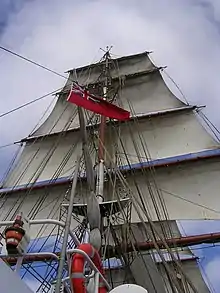Square rig
Square rig is a generic type of sail and rigging arrangement in which the primary driving sails are carried on horizontal spars which are perpendicular, or square, to the keel of the vessel and to the masts. These spars are called yards and their tips, outside the lifts, are called the yardarms.[1] A ship mainly rigged so is called a square-rigger.[2]
History

The oldest archaeological evidence of use of a square-rig on a vessel is an image on a clay disk from Mesopotamia from 5000 BC.[4] Single sail square rigs were used by the ancient Egyptians, the Phoenicians, the Greeks, the Romans, and the Celts. Later the Scandinavians, the Germanic peoples, and the Slavs adopted the single square-rigged sail, with it becoming one of the defining characteristics of the classic “Viking” ships.[5]
See also
References
- Oxford English Dictionary
- Keegan, John (1989). The Price of Admiralty. New York: Viking. p. 280. ISBN 0-670-81416-4.
- Mannering, Julian, ed. (1997). The Chatham directory of inshore craft : traditional working vessels of the British Isles. London: Chatham Pub. ISBN 1-86176-029-9.
- Early Boats, in Shipwrecks and Submerged Worlds. University of Southampton. https://www.futurelearn.com/courses/shipwrecks/5/steps/96495 Retrieved 2018-8-20
- The Viking ship's single square-rigged sail. http://Longshipco.org/sail.html Retrieved 2018-8-20
